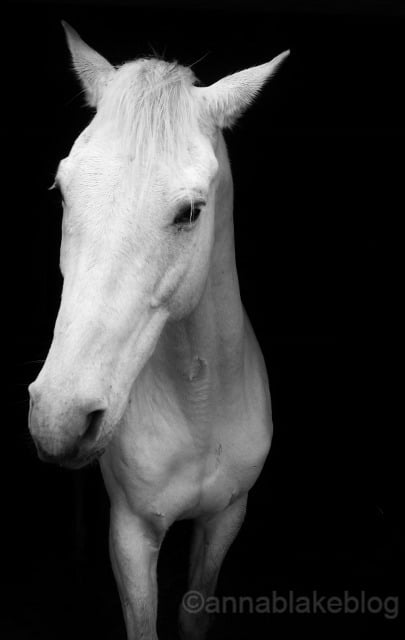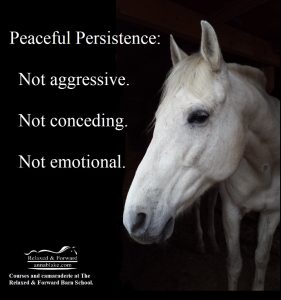
A reader request: “I hope you will someday do an article on looking at the horse’s ears and eyes to determine happiness. I see pics of people smiling on horses that are clearly unhappy or in pain or both. It boggles my mind that they are oblivious to it. Just recently saw a photo of someone I know on her very old somewhat debilitated Arab mare – bareback and bridle-less and the horse’s ears were almost flat back.”
The reader is smart to ask me, it’s what I do for a living. Helping riders understand what horses are asking us. But it’s always easy to be a railbird when it comes to other people’s horses. It takes no skill to find faults. Even if we bite our tongues and don’t want to say it, we’re haunted. We feel fine criticizing Olympic riders without posting a video of our riding. It’s open season for criticism. Then, someone in a holier-than-thou voice chimes in that if there’s a rider with no fault, let them first cast a stone. Now we feel guilty for judging, worse for mentioning it, and the horse is still suffering. Encouragement would go further, for horses and riders.
It’s my job to find a cheerful and positive way to tell riders that their horse is in pain or they’re doing something wrong. No one is happy to hear it from me either. But our eyes hurt and we’re no fun anymore. Meaning just like the reader, we’ve developed the ability to read horses’ emotions, written all over their bodies in Calming Signals. Once you see it, you can’t unsee it. Now you live in the actual world of horses, and it isn’t a romantic place. But horses have much more body awareness than we do, and we have some catching up to do. Riding well takes a lifetime to learn.
The only solution to what we see others do on horseback that sounds ethical to me is to fix ourselves. If you believe that being concerned for your horse’s mental health is as important as their physical health, then do the work and lead by example. Then someone with a much-less-holy voice chimes in that it isn’t fair if we get judged. Right again. Every horse is different. Training has to be a priority and it will take energy. If we’ve mainly been training from a chair in the living room, it takes will, vulnerability, and perception to stay the course. There are always good excuses for not training and evolving with your horse. It’s hard work. If you claim the high ground and don’t ride, know that your horse doesn’t differentiate between riding and groundwork.
A common excuse for not working with a horse is that it’s a solitary path. Even in the middle of a crowd, it’s just you and your horse. It’s hard to stay on track, understand what your horse is doing, and alter the plan to work better. Working with a trainer gives us a guide on the path. It’s often said that riding lessons are the best investment you can make for your horse. I would add that if you don’t feel that way, maybe you haven’t tried it with a good instructor. Yes, it means the rider will feel like a bug under a microscope, but isn’t that what we do watching others? Isn’t it time to finally listen to the horse and learn?
Want to know my least favorite excuse? Not surprisingly, it’s when someone tells the old story about a bad trainer they tried once and then decided to never work with a trainer again as long as they live. I’ve heard it dozens of times. If it makes you feel better, fine. Meanwhile, the horses are a year older, and our riding hasn’t improved, but it’s still up to us to be the change we want to see. Have you tried serious homeschooling?
Start here: Have a goal because focus is the natural state for a horse, and they like us that way. It isn’t about reaching the goal quickly, it’s about having a destination, not that you care. Having an affirmative plan gives a horse confidence, rather than just lollygagging around aimlessly looking for things to spook at.
Then, let’s put our keen railbird eye to good work. Take your cell phone to a place with a view of your riding area. You can buy a cheap flexible tripod that will grab a post, but the usual twine or duct tape works, too. Or invest in a Pivo. Start the video and move to the mounting block. Notice that you feel self-conscious but let that be a good thing. Maybe you’ll feel something you didn’t know. Just ride for five minutes, short and sweet, and climb down. Transfer the video to a large-screen computer or watch it on your TV, not your phone.
Make some popcorn. The first dozen times you watch the video, just see the horse. On one viewing, just his eyes. Next, his ears, nothing else. Then watch only his muzzle. Then just his poll. Don’t multitask here, just watch one thing and rewind. You are learning to focus. Then his tail. The length of his stride, how his hooves hit the ground. Is he lifting his back? Scrutinize every “word” your horse says. Don’t tell a story for him, let him have his own voice. Listen with your eyes. Movement is life to a horse.
The second dozen times you watch it, isolate parts of your body. Notice your shoulders, notice your jaw. Are your arms elastic? How is your energy level, are your sit bones communicating? Let your thighs be relaxed. Could you ride with an egg under your knee? Are your ankles soft? Can you feel your little toe on the stirrup? Does any part of your body restrict the movement of your horse? Could your body encourage your horse’s stride to be energetic and relaxed? Can you give your horse a massage during a ride, by systematically warming up one area of his body at a time?
Am I nitpicking? Let’s ask your horse, sensitive enough to feel a fly. You can homeschool your riding, but you can’t trust your brain. Luckily, we have instant replay. Improve your riding so you are easier for your horse to carry. Work affirmatively with your horse, no corrections. Do the same with yourself.
And if you have questions, be courageous. Ask for help. A virtual lesson can be live if there is Wi-Fi in the barn, but sharing videos in Zoom is highly effective as well. Since the beginning of COVID-19, I’ve given riding lessons around the globe, and the horses have blossomed. They like working from home, and people make incredible progress in online courses. And it isn’t just me. Technology makes it possible to work with anyone you like. There is no distance between us now. Horses like that there is no trailering involved.
One favor, please. If you want to complain about nasty trainers, well, no argument. They exist, but there are way more good trainers who sit up late working on how to help their riders. If you don’t believe it, send me (or any trainer you like) your video and schedule a lesson.
This whole subject isn’t about humans. We chatter on, but it’s about equine welfare. Isn’t it time to skip the new saddle pad and instead, invest in your horse by investing in yourself?

…
Undomesticated Women, Anectdotal Evidence from the Road, is my new travel memoir. Ride along over 30 states, 2 oceans, and 14k miles with me and my dog, Mister. Available at all online booksellers and from me, at the end of October.
…
If you appreciate what I do, please Subscribe to this blog or join us at The Barn School.

Anna Blake, Relaxed & Forward
Want more? Become a “Barnie.” Subscribe to our online training group with affirmative demonstration videos, audio blogs, daily quotes, free participation in “group lessons”, and live chats with Anna. Become part of the most supportive group of like-minded horsepeople anywhere.
Anna teaches ongoing courses like Calming Signals and Affirmative Training at The Barn School, along with virtual clinics and our infamous Happy Hour. Everyone’s welcome.
Visit annablake.com to find archived blogs, purchase signed books, schedule a live consultation, subscribe for email delivery of this blog, or ask a question about the art and science of working with horses.
Affirmative training is the fine art of saying yes.
…
I think your suggestions for scrutinizing oneself and horse are so helpful, and sort of scary as well, due to how hard it is to be “objective” and our tendency to judge rather than observe.
I do wonder why you say “your horse doesn’t differentiate between riding and groundwork.” Wouldn’t it be more accurate to say that some horses don’t, while some definitely do?
Being objective about anything is hard, but we need to be better communicators with horses.
And in my experience, relationship is the question for horses, on the ground or mounted. If I was asked to prioritize, I would say we are more intimidating on the ground, as counter intuitive as it sounds. So much of the groundwork we do is more aggressive than we know.
Thank you for this wonderful post, Anna.
I never ride without having a lesson and I have found an amazing instructor.
Good for you! Thanks, Shelly
Thank you Anna. I have a pony that a I have gone through a lot of investigation on his attitude because of his ears. He told me he didn’t like being called my pony so I call him my little man. That agrees with him. The vet has looked at him, took some xrays, has some arthritis in left hock, ok so we have tried osphos. No difference. Then I found out that that in the process of bone formation, it stops one side of the bone building process. I would have to find the article to find out exactly, but not so good. He is on a joint supplement.
I have had saddles fitted for him. He is like the princess and the pea. If it is not right he would not stand for me to get on or anyone else. When I got him he would bite at you when girthing. I never girth up quickly anyway, so we have worked on that. He will still remind me if he thinks I am going to do it to quickly. So now a lot of what he does is to lick the cross tie pole, whether he is ground tied or just on the one clip. That is his self soothing. The biggest problem is his ears are still back most of the time. This has gotten better, but still there. Not flat back, but more like listening back. If he sees or hears something they do go forward. Still searching on this one. I would like him to be a happy boy. Maybe he is and he is just really concentrating. I have a new trainer coming on Sunday and she will work with him and I will see what she thinks. The search goes on.
Would you please tell me when exactly your Sunday discussions are? I was able to join one a long time ago and really enjoyed it, but I can’t seem to find the saved ones either. Thanks.
Thanks Virginia. You are doing a good job searching for answers. Many of the symptoms you list could be pain related, and I don’t know enough about your horse to guess, but the symptoms are there.
I think you are talking about our Happy Hour discussions, but they are not just on Sundays. We have one later today. http://www.relaxedandforward.com, and they are under the ‘Topic’ section.
Good luck.
I just love the idea of isolating each body part – for both horse and human – to focus on during a video replay. In my time actively training my horse, it would have been so helpful to have it on hand to watch with a trainer.
Well done, Anna, for turning a health hazard – Covid 19 – into a win for your clients!
Thanks, Lynell. It was how I learned; too overwhelming to watch it all at once.